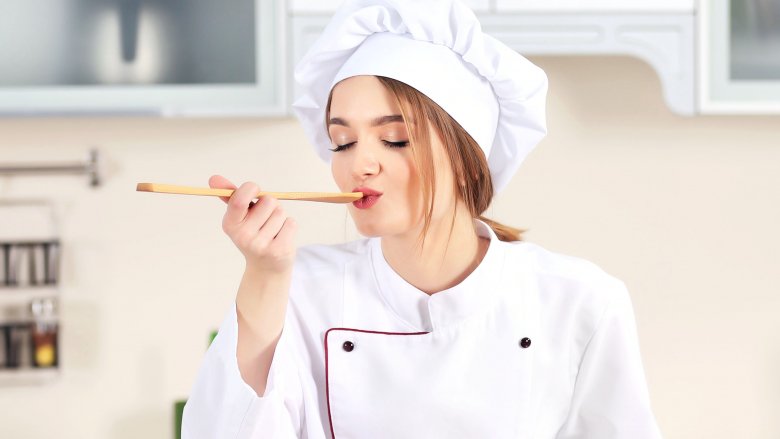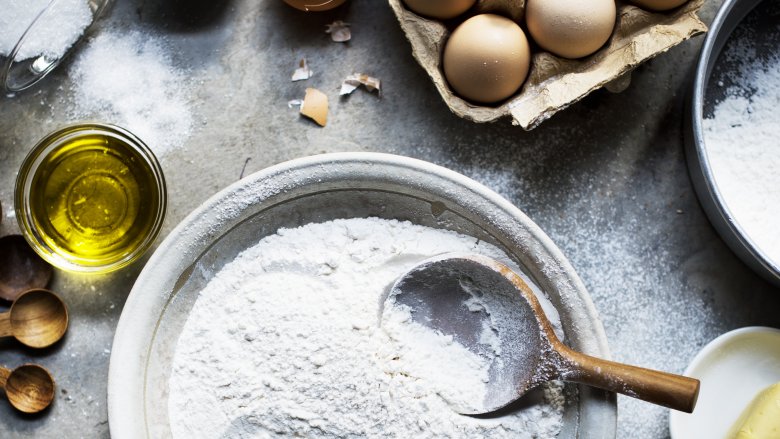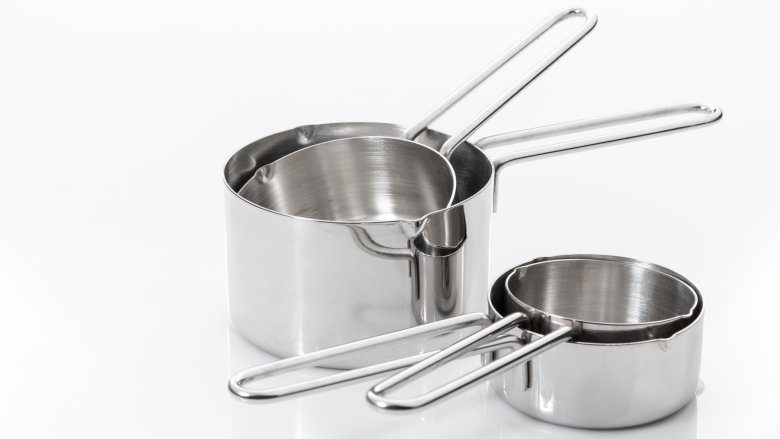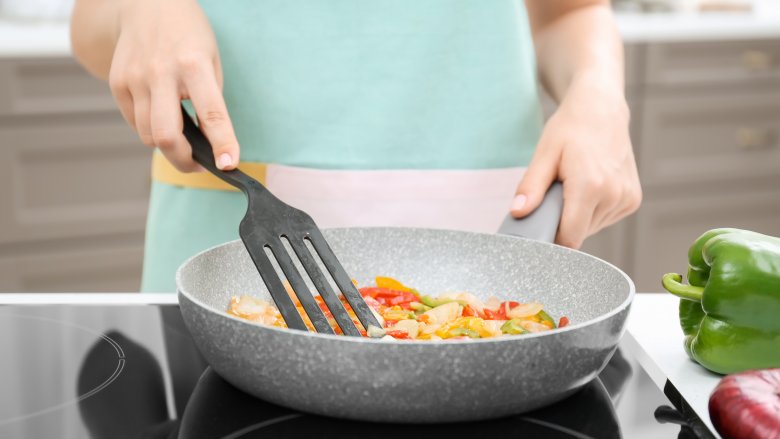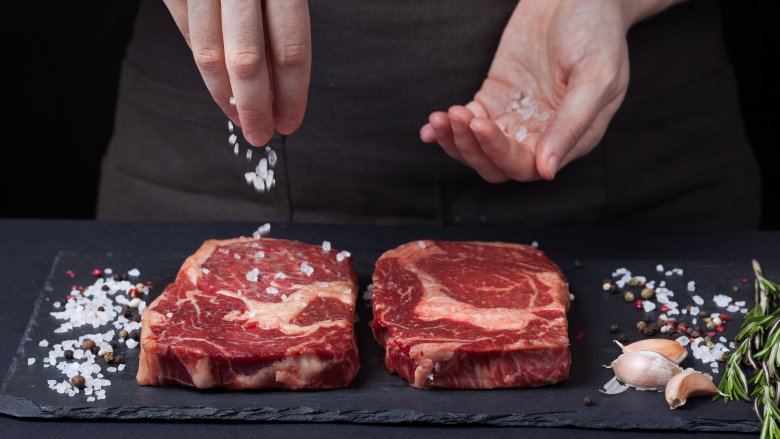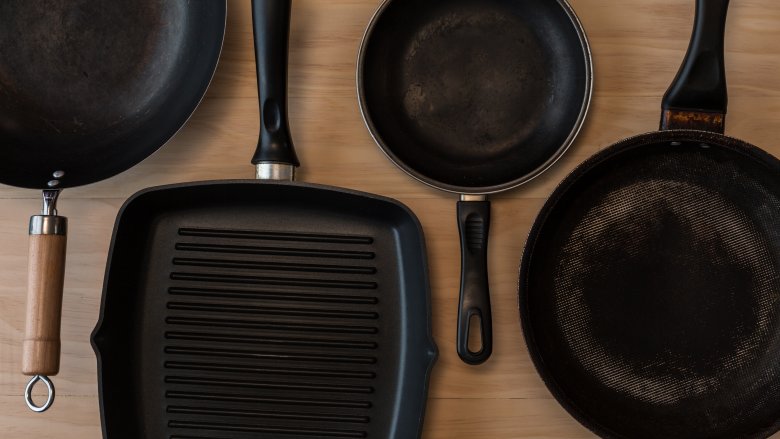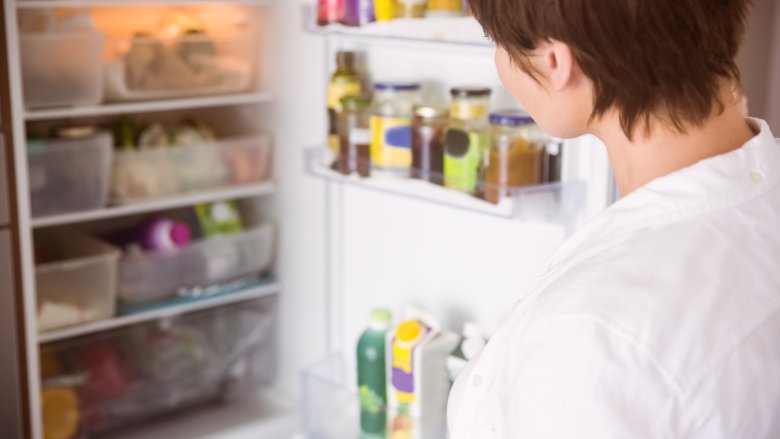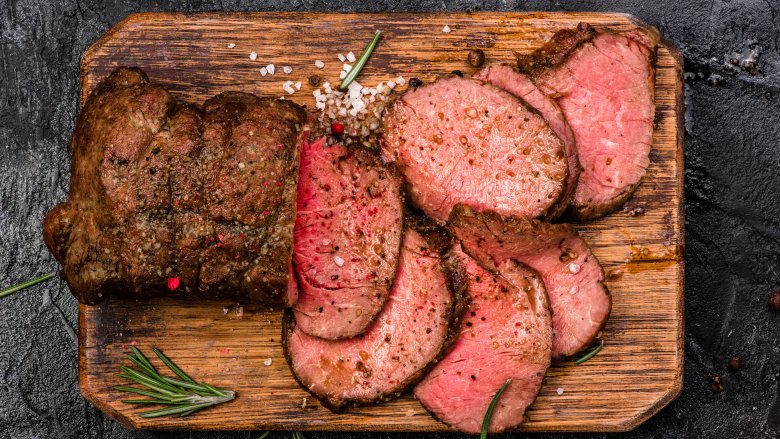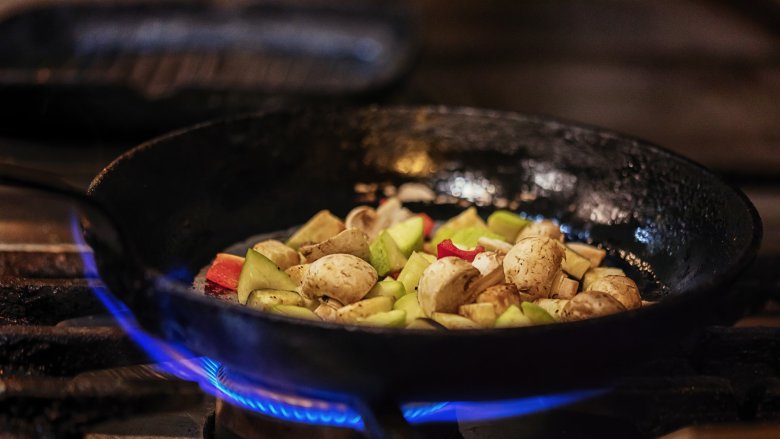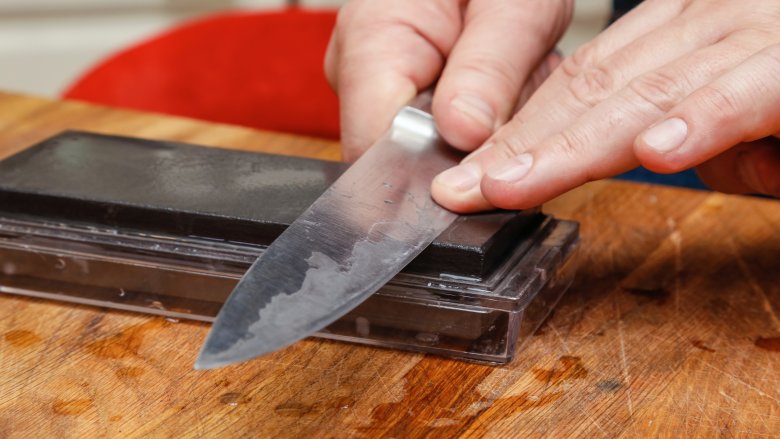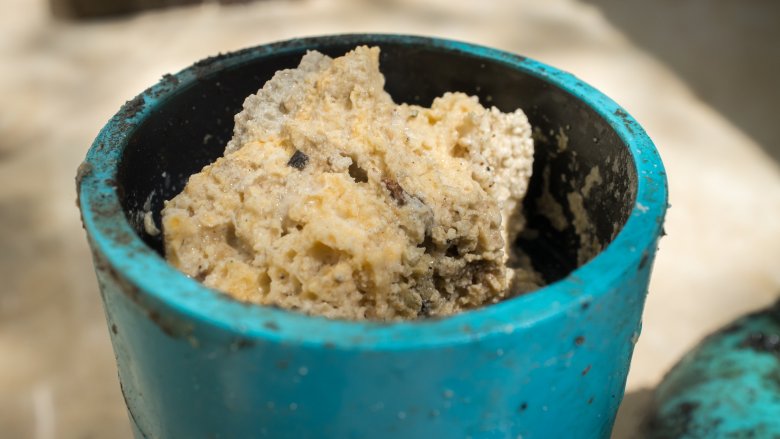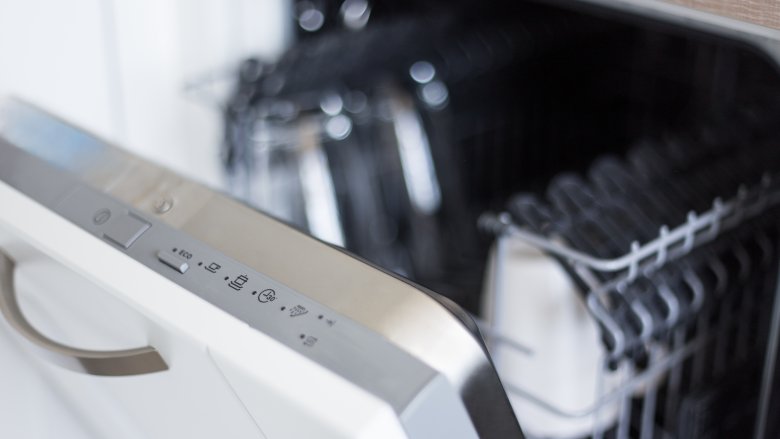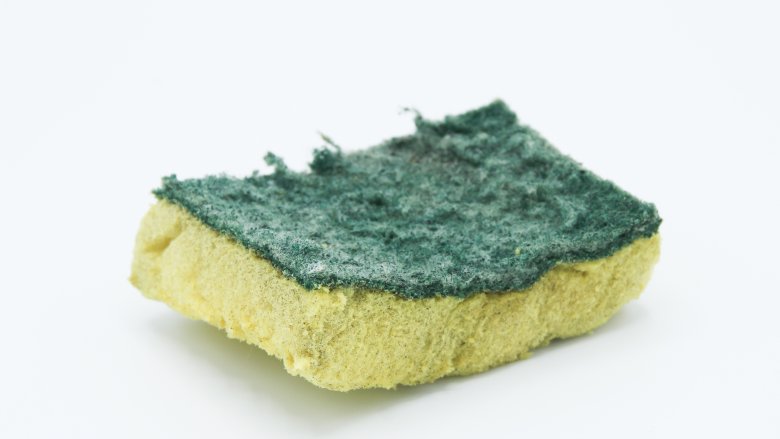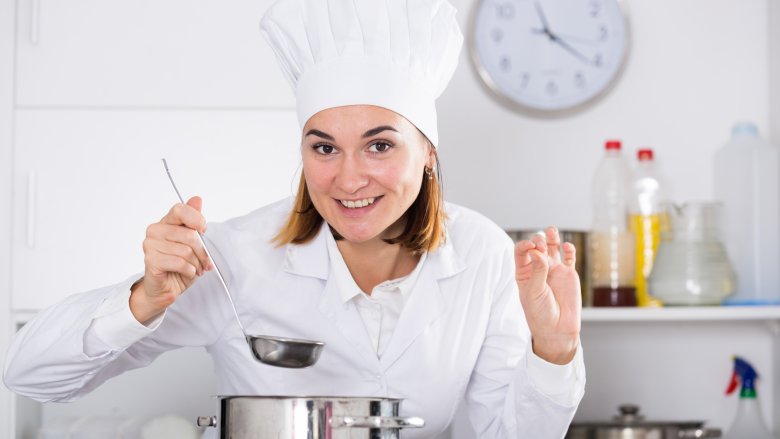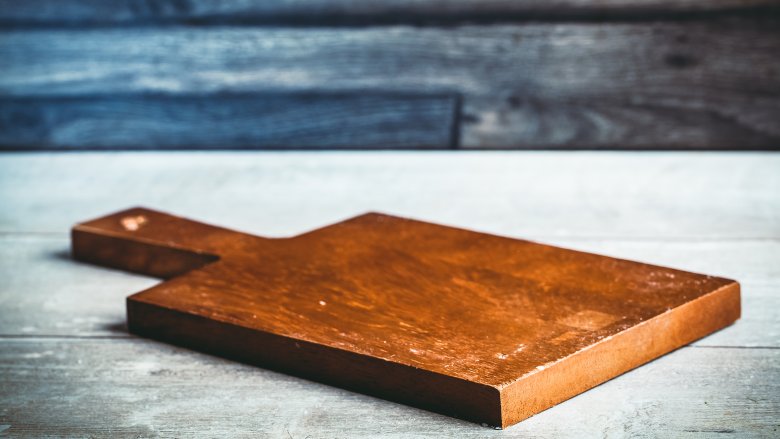Bad Kitchen Habits You Need To Break Right Now
Look, nobody's perfect. Even if you're expertly churning out the entire repertoire of Julia Child recipes on a regular basis, and can whip up a perfect souffle with one hand tied behind your back, there's still a good chance that you're making some of these most grievous of kitchen mistakes.
Don't believe us? We've compiled a list of the most common kitchen errors that many of us are making daily — maybe it's because you've forgotten the way you should really be doing it, or maybe it's because you think your way is better (but it's probably not). Which ones would get you a place on the kitchen naughty list?
Not following recipes when baking
You may love to experiment with a pinch of this or a dash of that when cooking, but when it comes to baking, that recipe is more important than you may realize. Why is that? Because science is at work in your favorite baking recipes. In baking, it's important to get the right ratio of tenderizers (like fat, sugar, and leavener) to tougheners (like flour, water, egg whites) in order to produce a baked item that delivers the proper moistness, elasticity, or fluffiness. According to Crafty Baking, every single measurement and ingredient in your favorite recipe has a specific reasoning behind it, and if you alter it, you probably won't get the final result you were hoping for.
Not measuring dry ingredients properly
We already know that baking is a science, and one thing I definitely remember from science class is the importance of measurements. That's why, when you're measuring ingredients for your favorite cake, pie, or cookies, it's crucial that you use the proper tools, and use them correctly.
Yes, there really is a difference between the measuring cups that are made for liquids or dry goods. Dry measuring cups are designed with a top that can be easily leveled with a butter knife. Flour, white sugar, and leaveners should be scooped and leveled, while brown sugar should be packed before leveling. For liquid ingredients, use measuring spoons or liquid measuring cups and look at them from eye level to get the most accurate reading.
Want even more precision in your measurements? Invest in a kitchen scale to bake like a pro.
Not preheating pans
Ever dumped scrambled eggs into a cold pan and wondered why they took forever to cook (and stuck mercilessly to your pan)? Just like you preheat your oven before popping in your dinner, you should also be preheating your stovetop pans before cooking.
No surprise, it's science again that explains why a preheated pan will deliver crispier, more evenly cooked meats and veggies in any recipe. As a pan heats, microscopic gaps in its surface expand, leaving little for your food to stick on to. Even a high-end, super smooth pan can cause meat to stick, as the meat forms a molecular bond with the metal in the pan. Heating oil in the pan while you preheat it will stop this from happening, and the oil will give you a clearer indication of just how hot your pan actually is.
It is important to note, however, that you do want to exercise some caution when preheating non-stick pans, which can reach unsafe levels of heat fairly quickly. When preheating non-stick cookware, give it a quick preheat, along with your cooking oil, and be ready to start cooking as soon as you've brought its temperature up.
Not using enough salt
Yes, we all know the health police don't want us to consume too much sodium. But, the truth is, 75 percent of the sodium we get in a day is not from food we're making at home, but rather from the foods we're eating that are processed, or from a restaurant. Time reports that the salt added in typical home cooking only accounts for five or six percent of the sodium we consume.
So what does this mean for you, the home cook? If your dishes always seem bland... add more salt! And not just at the end of your cooking process, but rather, throughout cooking. Adding salt only at the end of cooking doesn't allow the salt time to penetrate your food — it will only cling to the outer surface, which will make your food seem far too salty. Adding salt earlier when cooking will significantly change the finished flavor of your recipe, and you'll be glad you did.
Using an old non-stick pan
You've no doubt heard by now of the danger of Teflon-coated, non-stick pans causing dangerous fumes at high heat. Chipped and scraped pans are even more likely to emit harmful fumes, not to mention transfer flakes of coating into the food you're cooking. Even non-stick pan manufacturer, DuPont, recommends tossing a pan after just three to five years of usage.
The good news is, there are safer alternatives to those old, Teflon-coated pans, that provide the same non-stick features you love, without the fear of harmful fumes or particles on your food. While priced a bit higher than your traditional non-stick pans, they offer longer life spans, and are free not only from Teflon, but also free from the common coating known as polytetrafluoroethylene, or PTFE, which releases a toxic fume, perfluorooctanoic acid (PFOA), at high temperatures. According to Organic Authority, pans with a ceramic coating, or that use sand or stone for a non-stick coating, are a safer bet if you're not into replacing your pans every few years.
Storing food the wrong way
Old habits die hard. Maybe you're still storing your bread and tomatoes in the refrigerator because your grandma used to do it that way, but that's not where they go. What other foods are no-no's? Fresh basil will fare better when treated as a fresh flower — trim the stems and place in a glass with some water. Potatoes, garlic, and onions prefer dark, cool, well-ventilated areas, and coffee should be kept in a tightly-topped container in your pantry. And what about honey? Honey doesn't spoil, so you can leave it out at room temperature so it doesn't become too hard to pour.
Not letting meat rest
We get it... you're hungry, and that rib-eye you've just lovingly grilled is filling your nostrils with its seductive aroma. Maybe you've been fantasizing about dinner for the past three hours, and waiting another 10 or so minutes feels like torture. But do you and your pricey steak a favor, and fight the temptation!
According to the Food Lab at Serious Eats, a steak loses about 13 percent of its weight during cooking, but slicing it open when it's just off the heat will result in another nine percent loss. And what does that loss represent? Juices! Tasty juices that are holding a whole lot of flavor. A single portion of steak will need a solid ten minutes of rest. Larger cuts, like a prime rib, might need up to 45 minutes. You could calculate about ten minutes per pound, or, use a meat thermometer. The meat is ready to be sliced when the internal temperature has been reduced to 120 degrees Fahrenheit.
You overcrowd your pots and pans
We love the ease of one-pot cooking as much as the next person, but sometimes you just need to face the facts, and accept that the size of the pot or pan you're using is too small for the job at hand. Ever tried to use a too-small pot to boil a pound of pasta, and wonder why your pasta turned out clumpy and improperly cooked? That pasta needed room to move, and you weren't doing it any favors by trying to cook it in that one-quart pot.
The same rule holds true for food you're cooking in a pan. If you're crowding veggies, meat, noodles, or just about anything into a pan, the food overlapping itself is just going to create steam, and leave you with a steamed meal, when what you may have wanted was something crispy and browned. Give that food some room to breathe, and cook in batches if necessary. It may take more time, but you'll reap the rewards.
You don't sharpen your knives
When a knife is sharp, it makes your job so much easier. You can work faster, and safer. You can achieve precision in your dices and minces that you wouldn't be able to with a dull knife. And forget about carving meat. Carving meat with a dull knife turns into a hack job in seconds. So how often should you be sharpening your knives? Once every couple of weeks is the rule of thumb, and you should also be honing it with every use.
You're pouring grease down your drain
If you're going to kick just one habit on this list, you may want to make this the one. Pouring grease down your drain can cause major problems in your home's plumbing system, but it can also have serious implications for the environment, and your community's sewer and water systems. In case you've never heard of a "fatberg," allow us to clue you in. Fat and grease that builds up in sewage systems over time teams up with the calcium found in sewers to create massive, soap-like "fatbergs" that cling to the ceilings of the sewer system. If left to its own devices, a fatberg can cause a sewage backup in your neighborhood, and even affect your community's ability to create safe drinking water.
So what to do with all that oil and grease? If it solidifies, like bacon grease, pour it into a jar that you store in the freezer, and dispose of it when it's nearly full. Liquid oils should be disposed of with your trash as well. If you're making something massive, like a fried turkey, check to see if your town offers oil recycling, which they may use to create clean bio-fuel.
You're putting the wrong things in the dishwasher
It's undoubtedly an amazing appliance, but there are, unfortunately, quite a few kitchen items that should never visit the inside of your dishwasher. Wooden utensils can get warped and cracked in a dishwasher's high temps. Cast iron pots and pans will be robbed of their valuable, time-earned seasoning. Copper can be permanently discolored, and crystal can become cloudy. Check out our definitive set of guidelines to learn all the items that you just need to say no to when it comes to washing them in your dishwasher.
Using a dirty sponge
When is the last time you switched out that sponge? Longer than you can even remember? According to the cleaning experts at Angie's List, you should aim to use that sponge no longer than one month, or about 30 overall uses. To keep your dish sponge fresh, consider popping it in the dishwasher, or cleaning your dish sponge with bleach and hot water. Or buy sponges in bulk when they're on sale, and switch out for a new one every two weeks. Remember to keep a separate sponge available for other household cleaning projects.
Tasting with your cooking utensils
Who of us here hasn't been guilty of this kitchen faux pas? It's so easy to sneak a quick taste to make sure you've got the seasonings just right — and it's just as easy to continue to stir with that same spoon. According to the professional kitchen guide, Practical Cookery, a cook should use a clean teaspoon, or plastic utensil that can be immediately disposed of, each time a dish is tasted. They also advise refraining from nose blowing, skin scratching, ear rubbing, and coughing or sneezing anywhere near the food prep area, to avoid nasty bacteria getting into your meal.
Always using the same cutting board
There are probably a lot of home cooks that use the same wooden cutting board for just about everything they do in the kitchen.
But, according to North Carolina University, we should all really be using separate cutting boards for meat and non-meat items. Plastic would be the preferred choice for meat, as plastic cutting boards can be sanitized more easily, though they are also more prone to deep grooves that can harbor bacteria. The most important thing is to wash and sanitize your cutting boards after using them, and to make sure they get completely dry before you store them — bacteria loves warm, wet places.
